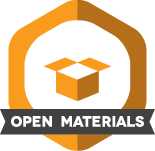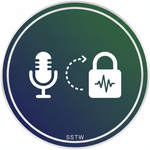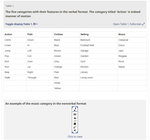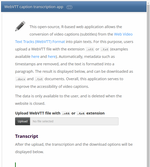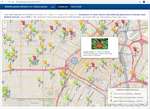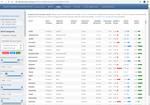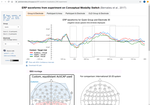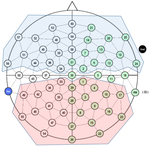Since 2018, I have advised numerous students and colleagues on designing and conducting behavioural and EEG experiments, as well as on the management, preprocessing and analysis of data. For instance, during my PhD, I supervised an undergraduate internship. During my postdoctoral fellowship at UiT, I supervised three research assistantships and co-supervised a master's thesis. Furthermore, I am a certified Carpentries Instructor, and have designed and led several workshops on data analysis using . Earlier in my career, I taught English to secondary-education students in Spain, and taught Spanish to adults in Lithuania.
During my PhD, I held a graduate teaching assistantship that involved 180 hours of teaching annually, covering seminars, essay marking and lab sessions. Each year, I led 30 seminars and marked 80 essays in developmental, cognitive and social psychology, while also helping in 30 statistics lab sessions (activities summarised below). Furthermore, I was a representative for graduate teaching assistants in the department for a year.
| Year |
Course and remit |
| 2021–22 |
Introduction to developmental psychology (115) — Seminars and essay marking |
|
Introduction to neuroscience (112) — Seminars |
|
Introduction to cognitive psychology (111) — Seminars and essay marking |
|
Social psychology in the digital age (113) — Seminars |
|
Statistics for psychologists I (121) — Lab sessions |
| 2020–21 |
Introduction to developmental psychology (115) — Seminars and essay marking |
|
Introduction to neuroscience (112) — Seminars |
|
Introduction to cognitive psychology (111) — Seminars and essay marking |
|
Social psychology in the digital age (113) — Seminars |
|
Statistics for psychologists I and II (121 and 122) — Lab sessions |
| 2019–20 |
Understanding psychology (101) — Seminars and essay marking |
|
Cognitive psychology (201) — Seminars and essay marking |
|
Master's statistics (401) — Lab sessions |
| 2018–19 |
Understanding psychology (101) — Seminars and essay marking |
|
Investigating psychology: Analysis (102) — Lab sessions |
Lastly, I have created two web applications intended for educational contexts. One supports the simulation of data, enhancing the teaching of statistical principles, while the other streamlines the transcription of video captions for use in multimedia learning environments.
Teaching Philosophy
My teaching experiences have honed my ability to create a collaborative and engaging learning environment, where students are encouraged to think critically and apply their knowledge effectively. As a result, my teaching approach ensures that students not only acquire foundational knowledge but also develop the skills necessary to excel in their academic and professional endeavours. To this end, I draw on a range of applications that foster participation and collaboration, including MS Teams, Google Docs, GitHub, Mentimeter, Vevox, Miro, etc.
I have been guided by a few core principles that are outlined below.
Situating Cognitive Faculties in Meaningful Contexts
I strive to situate the concepts I teach in the appropriate contexts. For instance, language is produced in the brain and in society. These contexts shape language as a human faculty and languages as human products. In the same vein, language shares the space with other cognitive faculties and other cultural products, which often help us understand language. By pointing out these contexts, I encourage students to explore perspectives beyond traditional boundaries. Indeed, my teaching incorporates insights from psychology, neuroscience, linguistics and cross-cultural research.
Connecting Theory to Practice
I strive to connect theoretical concepts to the methods that are used for their study. This helps prevent the disconnects that are occasionally experienced by students and academics, where there can be an unhelpful focus on a method without theory or a theory without method.
My commitment to open science and reproducibility informs my teaching. By embedding these principles into research workflows, I help students produce reliable and sustainable scholarship that is can withstand the test of time. In practical terms, these standards are designed to (1) enhance the quality of research, (2) optimise the use of academic resources in the medium and long term by facilitating access to and reuse of research materials, and (3) enhance students’ professional prospects by equipping them with a high-value, translatable set of skills.
I would like to continue honing these principles, aided by the advice and inspiration from more experienced colleagues and by the regular feedback from students.
Some Possible Courses
Below, I present some examples of courses that I would like to teach. Blending interdisciplinary perspectives with rigorous methodological training, these courses include explorations of language and cognition, cutting-edge research techniques, and best practices in reproducibility and data visualisation.
1. Introduction to the Psychology and Neurobiology of Language
This course explores the intricate relationship between language, cognition and neurobiology, providing students with a foundational understanding of how language is processed and represented in the mind and brain. Topics include the historical and evolutionary development of language, mechanisms of comprehension and production, and the cognitive processes underpinning bilingualism and multilingualism. Additionally, the course examines the interactions between language and cognitive functions like executive control and sensorimotor simulation, culminating in an in-depth discussion of linguistic relativity.
2. Research Methods in the Psychology and Neurobiology of Language
Focusing on the methodological challenges and opportunities in studying language and cognition, this course provides students with the tools to design and conduct world-class crosslinguistic research. Students will tackle issues such as overcoming biases inherent in WEIRD (Western, Educated, Industrialised, Rich and Democratic) samples and identifying meaningful crosslinguistic patterns. The curriculum integrates theoretical frameworks, such as modularity versus holism, with practical training in experimental paradigms and methods that have become essential. Emphasis is placed on the use of psychophysical and neuroimaging techniques, including electroencephalography, magnetoencephalography, functional magnetic resonance imaging, eye-tracking and pupillometry, to provide a comprehensive understanding of the methods driving the field forward.
3. Electroencephalography
This course immerses students in the theory and application of electroencephalography (EEG) for studying cognitive processes, with a focus on language and decision-making. Students will gain a historical perspective on EEG research and a practical understanding of its implementation in Psychology and Linguistics. Key topics include event-related potentials, time-frequency analysis and experimental designs. Through a combination of lectures and laboratory sessions, students will gain the theoretical and technical skills needed to design and conduct EEG studies. As part of this work, students will practice how to search for solutions reliably and responsibly by drawing on community forums, business support services and artificial intelligence applications.
4. Increasing Reproducibility Throughout the Workflow of a Study
Reproducibility is a cornerstone of scientific integrity, and this course empowers students to embed reproducible practices in their research workflows. Grounded in open science principles, students will examine the role of Psychology in the replication crisis, and become familiar with methodological frameworks like FAIR, which helps create more Findable, Accessible, Interoperable and Reusable data. Practical sessions will focus on implementing tools such as the Open Science Framework and R Markdown, while providing training in reproducible experiment design, data analysis and manuscript preparation. As part of this work, students will practice how to search for solutions reliably and responsibly by drawing on community forums and artificial intelligence applications. By the end of the course, students will be equipped to produce transparent, replicable research that meets the highest standards of scientific rigour.
5. Data Visualisation
Effective data visualisation is crucial for interpreting and communicating our research, and this course teaches students how to achieve this using R. With an emphasis on clarity and accessibility, students will learn to create a variety of visualisations, from static plots to interactive web applications. The course covers best practices for summarising data, combining plots and integrating tables into reports. Practical sessions provide experience with advanced visualisation techniques, ensuring students can present complex data in an engaging and professional manner. As part of this work, students will practice how to search for solutions reliably and responsibly by drawing on community forums and artificial intelligence applications.
These courses collectively emphasise the integration of theory and practice, reproducibility and methodological innovation. My academic experience in linguistics, psychology, statistics and research methods directly informs the design of these courses, ensuring that students gain both foundational knowledge and practical skills to excel in their academic and professional endeavours.
6. Introduction to Statistical Analysis
This course provides a foundational understanding of statistical reasoning and methods, with an emphasis on transparent and defensible research practices. Using R as the primary tool, students will explore key concepts such as descriptive statistics, probability theory, hypothesis testing, correlation and basic linear models. Emphasis is placed on integrating statistical considerations into the early stages of research design, ensuring that methods are appropriately aligned with research questions and data structures. Through a combination of theoretical instruction and practical exercises, students will learn to justify their analytical choices and interpret statistical results with care and precision.
7. Advanced Statistical Modelling
Building on introductory concepts, this course equips students with the skills to conduct sophisticated statistical analyses using R. Topics include generalised linear models, multilevel (mixed-effects) modelling, model selection and comparison, approaches to handling non-normal and hierarchical data, and dimensionality reduction techniques such as principal component analysis and factor analysis. Throughout, students will be encouraged to consider statistical design and analysis as an integrated part of the research workflow, making principled methodological decisions in response to the specific demands of their data and hypotheses. The course also addresses challenges such as overfitting, multicollinearity and multiple comparisons, with a strong focus on transparent reporting and justification of analytical strategies. Practical sessions will provide hands-on experience with real-world data and complex experimental designs.
